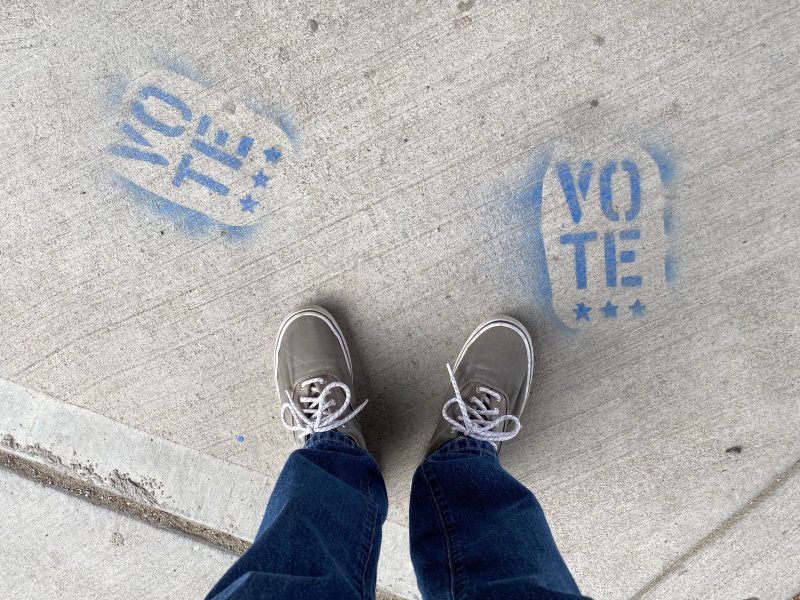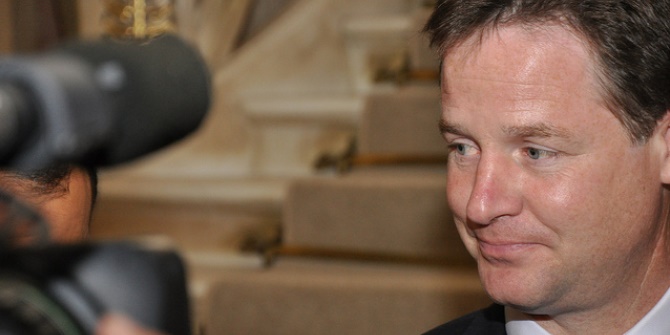
 Nick Clegg has occupied a significant place in the popular imagination of the British public since the General Election of 2010. The extraordinary character of politics has shone a more intense light on the Liberal Democrat party with its leader standing in its full glare. Katy Parry and Kay Richardson examine media coverage of ‘Cleggmania’ before and after the election and find an increasing personification of British politics with not-so-subtle undertones of homophobia and sexism.
Nick Clegg has occupied a significant place in the popular imagination of the British public since the General Election of 2010. The extraordinary character of politics has shone a more intense light on the Liberal Democrat party with its leader standing in its full glare. Katy Parry and Kay Richardson examine media coverage of ‘Cleggmania’ before and after the election and find an increasing personification of British politics with not-so-subtle undertones of homophobia and sexism.
The flurry of excitement provoked by Nick Clegg’s very sudden emergence into public visibility in April 2010 and his rise to the heart of government as Deputy Prime Minister offered a unique opportunity to observe the hasty moulding of a new political persona, but the Nick Clegg that the public has grown to know over the past 18 months is little more than a construct assembled from a range of semiotic resources distributed across the UK mediascape.
During 2010, we audited a range of politically-inflected media outputs in the UK, across media platforms and genres, encompassing editorial cartoons, parliamentary sketch-writing, comedy panel shows, blogs, reality TV and political programming (such as Question Time, This Week). This research forms just one part of a much larger study on the media and Britain’s cultural landscape that relates specifically to politics. Our study on Nick Clegg focuses on the repetitions and patterns of figurative language and visual imagery drawn upon in the efforts to organise, understand, mock or scorn the phenomenon of his sudden rise to prominence. Studying a range of serious and comic media forms has allowed us to trace the crucial inter-discursivity and interdependence of the various media constructions and interpretations of Clegg as a political actor, public celebrity and symbol.

The excitement when Clegg first emerged into public visibility was so marked that the term ‘Cleggmania’ quickly entered the political lexicon. Many comparisons followed, especially in the days after the first televised debate: he was the Susan Boyle of politics, due to his surprise performance in a TV ‘talent’ show; he offered Obama-like promises of hope and change (‘I wonder if Mr Obama knows that he, Barack, is the Nick Clegg of American politics’, Quentin Letts wrote in the Daily Mail; for Andrew Gimson of the Telegraph he was James Bond ‘abseiling into the headquarters of Goldman Sachs’
An interesting visual exemplar of this trend was the portrayal of Clegg as Pinocchio by cartoonist Martin Rowson in the Guardian. While this fictional character is a popular surrogate in cartoonists’ depiction of politicians, it is usually employed to caricature the politician as a liar, with Pinocchio’s nose outrageously growing as he tells more lies (e.g. Richard Nixon, George W. Bush). In contrast with such previous examples, Rowson fruitfully explores the alignments between Clegg and Pinocchio through the latter’s desire to be a ‘real’ boy, playing with the theme of Clegg as not quite a ‘real’ politician, an innocent or an amateur who has found himself in the murky world of politics. Such portrayals undermined Clegg on multiple levels; read in a straightforward manner, he was an inexperienced boy in a man’s world (in a male-dominated election); read alternatively, with a sceptical take on his supposed guilelessness, this ‘innocence’ was a cunning ruse to mask his political capabilities. The second reading, proffered at times in the right-wing press, posed Clegg as a double danger, not just destabilising the probability of a Conservative majority after the election but also bringing uncertainty to the political process itself.
Just as the boyishness and illusory qualities of Clegg were employed to define and diminish him, once speculation mounted around the possibility of a hung parliament and future coalition government, Clegg was re-cast as seducer and seduced, including in female form. Possibly prompted by general observations that Clegg was relatively young, ‘fresh-faced’, and traditionally handsome, in an agreeable rather than striking sense, the media conveyed some suspicion of his ‘good-looking’ appeal: “Clegg’s siren call is dangerously seductive… So, this evening, keep an eye on that smooth, good-looking guy on the left. He’s very persuasive” appeared in the Telegraph. As Clegg’s ‘seductive’ charm appeared to ‘work its magic’ with the public, a number of commentators questioned both his intentions and the fickle nature of the public’s approval:
Like so many Shirley Valentines, bored by staid, unchanging, grumpy normality and bowled over by a sudden exposure to youth, sunshine and charm, the voters of Britain are conducting a holiday romance with Nick Clegg. (editorial, Mail on Sunday, 18 April 2010)
The positioning of Clegg in the ‘holiday romance’ frame is not only dismissive of his popularity; it also introduces an element of narrative, a dramatisation of the election via an unconventional source domain. The indeterminate election result and the following phase of coalition talks, which saw Clegg negotiating alternately with both Cameron and Brown, would disrupt these cosy allusions.
When a weekend of coalition talks failed to produce a formal agreement, political commentators turned hostile towards Clegg and his team of negotiators. Although particularly in evidence in the right-wing press, the shift to characterising Clegg (and the Lib Dem leadership) as ‘tart’ or ‘harlot’ also stemmed from senior politicians, such as Labour MP David Blunkett (“Can you trust the Liberal Democrats? They are behaving like every harlot in history”), and unnamed Conservatives, who reportedly branded the Lib Dems “a bunch of tarts” (The Sun, 11 May 2010).
Once the coalition was formed, the unsavoury ‘tart’ storyline shifted to a ‘bromance’ or gay partnership, bolstered by a joint press conference held in the Downing Street Rose Garden in which Cameron and Clegg provided the perfect images of informal jocularity more associated with wedding speeches than government formation. In one broadcast, This Week used both Frank Sinatra’s ‘Love and Marriage’ and Rolf Harris’ ‘Two Little Boys’ to accompany the familiar images As Clegg’s foray into ‘big boys’ politics at the heart of government continues, his life as (a now rather broken) Pinocchio is ongoing in Martin Rowson’s cartoons, while others have cast him variously as Cameron’s butler, wife or dog.
Since then, we have also been able to observe Clegg’s fall from grace, compromised even more than politicians normally are by the realities of his role as the junior partner in a coalition government dominated by the Conservative party. The student protests of last winter were characterised by expressions of visceral anger, talk of ‘betrayal’ and claims of hypocrisy directed notably toward the Deputy Prime Minister. Clegg was the effigy of choice, to be burned or hanged during the November protests, while the Twitter-based crowd-sourced satire of #nickcleggsfault, which had initially mocked the right-wing press’ smear campaign, had by this point lost all of its ironic attractions. By the time of the AV referendum, exactly a year on from the general election, fellow supporters of the ‘Yes’ campaign asked Clegg to remain in the background, lest his association damage their own standing.
The material we have examined offers further evidence of ‘personalisation’ in British politics. This refers to the shift of emphasis on to the voice, body, personality and private life of the individual politician (especially the leader) and away from the policies and ideological differences between parties. At one level, the romantically and sexually themed metaphors to which so many observers were drawn when David Cameron and Nick Clegg undertook to negotiate a coalition government represented an innovative idiom for new times, in place of the clichéd deployment of metaphors drawn from war and sporting contests. At another level, however, this re-imagining of political activities through the idiom of romance was often underscored with more familiar patterns of sexism, homophobia and misogyny.
Politicians routinely attempt to craft their public and mediated personas, aware of the high price paid for the ‘wrong’ kind of visibility in the mediascape, whether that is a perceived lack of authenticity, morality or political judgement. Cartoonists, journalists, comedians, bloggers and citizens can play a part in the co-creation and contestation of such personas. But there is a related question to consider. As the story of Nick Clegg continues and other politicians perform in the multifaceted glare of a hybridised media environment, will the media penchant for sharp-tongued appraisal, satirical playfulness and distortive caricature of political bodies’ work to diminish or enhance democratic openness and public critique of the body politic?
This article is a shortened version of full-length article available from British Journal of Politics and International Relations.
Please read our comments policy before posting.








To what extent is this reaction a realisation by the media that they failed to do their homework on Nick Clegg in the period between his election as Lib Dem leader and the start of the General Election? Further, to what extent is this a failure of the media to understand the different political dynamics which have emerged as a result of the introduction of coalition government?
On the first question – Nick Clegg and the Liberal Democrats were always going to get a positive response from the first leaders’ debate – simply because Clegg remained relatively unknown as the media attention tended to focus on the Brown vs Cameron story – current prime minister vs potential prime minister. (In previous elections, the Lib Dems have tended to see their opinion poll rating rise during the controlled period of the election simply because they enjoy greater exposure.) Clegg’s performance in the first debate came across well – partly because the public didn’t know what to expect, partly because Brown and Cameron were used to debating with each other, and partly because, as a result of a lack of criticism from the media, Clegg did not have to defend himself in his performance against the preconceived ideas of the press and public. That the media were able to portray Clegg as some sort of Susan Boyle figure says more about the media’s failure to scrutinise him before the election period – had they been more diligent, he wouldn’t have put in a ‘surprise performance’.
On the second question – This failure has continued, only now it is a failure to scrutinise or even understand Clegg’s actual and potential role both as a figure in government and as the leader of the junior party in coalition. Clegg’s role now is badly understood by many, arguably including himself. The media has failed to debate the realistic expectations of coalition government, including the roles of the different participants, choosing instead to analyse events through a binary prism (if such a thing is possible) with Clegg’s position a 21st century version of David Steel’s Spitting Image puppet from the 1980s.
What is certain though is that should Nick Clegg continue to be Lib Dem leader at the time of the next election, his performance in the first leaders’ debate will not be such a ‘surprise’.